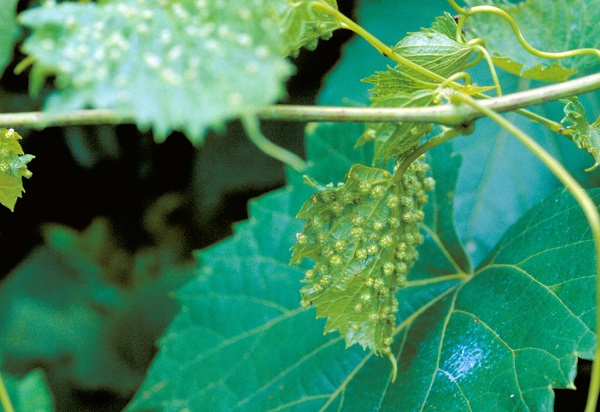Grape Phylloxera
ENTFACT-222: Grape Phylloxera | Download PDF
by Ric Bessin, Extension Specialist
University of Kentucky College of Agriculture
Grape phylloxera is native to eastern United States, but has been distributed to other grape regions of the U.S. and is also established in Europe where it is of great economic importance. The leaf galls caused by grape phylloxera are unsightly and do little damage, however, infestation of the roots can be difficult to control and can lead to severe root pruning and decline of vines. Severe infestations can cause defoliation and reduce shoot growth. Hosts include cultivated and wild grapes.

Figure 1. Phylloxera infested leaves often remain stunted in size.
The wingless forms of the insect are very small, yellow-brown, oval or pear-shaped, and aphid-like. The winged forms, which are less apt to be seen, are also aphid-like, except that wings are held flat over the back. Neither winged nor wingless forms have cornicles, tail pipe-like structures on the top of the abdomen, as aphids do. The presence of grape phylloxera is best recognized by characteristic galls it produces on the leaves or roots. Leaf galls are wart-like, about 1/4 inch in diameter, and are familiar to anyone growing grapes. Root galls are knot-like swellings on the rootlets, and may lead to decay of infested parts.
Root galls cause stunting and/or death of European varieties of grape vines. American varieties of grapes, European hybrids, or European grapes grafted onto American root stock are tolerant to the root gall form of the insect. Some varieties are resistant are to root galls, leaf galls or both.
The life cycle of grape phylloxera is complex due to the fact that generations with different life cycles may develop at the same time, at least in the eastern US. In spring, a female hatches from a fertilized egg that had been laid on the wood of a grape vine. She migrates to a leaf where she produces a gall and grows to maturity in about 15 days. She fills the gall with eggs and dies soon afterward. Nymphs that hatch from these eggs escape from the gall, and wander to new leaves where they in turn produce galls and eggs. There maybe 6 or 7 generations of this form during the summer.
In the fall, nymphs migrate to the roots where they hibernate through the winter. The following spring they become active again and produce the root galls on susceptible varieties of grapes. These wingless females may cycle indefinitely on the roots year after year. In late summer and fall, in the eastern U.S., some of the root inhabiting phylloxera lay eggs that develop into winged females. These females migrate from the roots to the stems where they lay eggs of two sizes, the smaller ones developing into males and the larger ones into females. Mating occurs and the female then lays a single fertilized egg that over winters on the grape stem. It is this egg that gives rise to leaf inhabiting generations.
It is important to note that phylloxera can cycle continuously as root inhabitants without leaf forms occurring, leaf inhabiting forms do not occur without the root form also present. Assume phylloxera is in all vineyards, regardless if the leaf form is observed.
On the west coast, there are grape phylloxera biotypes that can cause serious damage to hybrid rootstocks with any Vitis vinifera parentage. To date, these biotypes have not been reported in Kentucky.
Phylloxera Management
European varieties of grapes should be grafted onto American or hybrid grape root stocks. The leaf form of phylloxera can cause damage to some varieties. For this reason, foliar sprays to control phylloxera during vary depending on the variety and level of infestation.
Revised: 11/19
CAUTION! Pesticide recommendations in this publication are registered for use in Kentucky, USA ONLY! The use of some products may not be legal in your state or country. Please check with your local county agent or regulatory official before using any pesticide mentioned in this publication.
Of course, ALWAYS READ AND FOLLOW LABEL DIRECTIONS FOR SAFE USE OF ANY PESTICIDE!
Photos courtesy Ric Bessin, University of Kentucky Entomology
